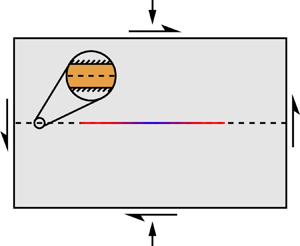Article contents
Self-similar fault slip in response to fluid injection
Published online by Cambridge University Press: 12 October 2021
Abstract

There is scientific and industrial interest in understanding how geologic faults respond to transient sources of fluid. Natural and artificial sources can elevate pore fluid pressure on the fault frictional interface, which may induce slip. We consider a simple boundary value problem to provide an elementary model of the physical process and to provide a benchmark for numerical solution procedures. We examine the slip of a fault that is an interface of two elastic half-spaces. Injection is modelled as a line source at constant pressure and fluid pressure is assumed to diffuse along the interface. The resulting problem is an integro-differential equation governing fault slip, which has a single dimensionless parameter. The expansion of slip is self-similar and the rupture front propagates at a factor  $\lambda$ of the diffusive length scale
$\lambda$ of the diffusive length scale  $\sqrt {\alpha t}$. We identify two asymptotic regimes corresponding to
$\sqrt {\alpha t}$. We identify two asymptotic regimes corresponding to  $\lambda$ being small or large and perform a perturbation expansion in each limit. For large
$\lambda$ being small or large and perform a perturbation expansion in each limit. For large  $\lambda$, in the regime of a so-called critically stressed fault, a boundary layer emerges on the diffusive length scale, which lags far behind the rupture front. We demonstrate higher-order matched asymptotics for the integro-differential equation, and in doing so, we derive a multipole expansion to capture successive orders of influence on the outer problem for fault slip for a driving force that is small relative to the crack dimensions. Asymptotic expansions are compared with accurate numerical solutions to the full problem, which are tabulated to high precision.
$\lambda$, in the regime of a so-called critically stressed fault, a boundary layer emerges on the diffusive length scale, which lags far behind the rupture front. We demonstrate higher-order matched asymptotics for the integro-differential equation, and in doing so, we derive a multipole expansion to capture successive orders of influence on the outer problem for fault slip for a driving force that is small relative to the crack dimensions. Asymptotic expansions are compared with accurate numerical solutions to the full problem, which are tabulated to high precision.
- Type
- JFM Papers
- Information
- Copyright
- © The Author(s), 2021. Published by Cambridge University Press
References
REFERENCES
- 11
- Cited by



